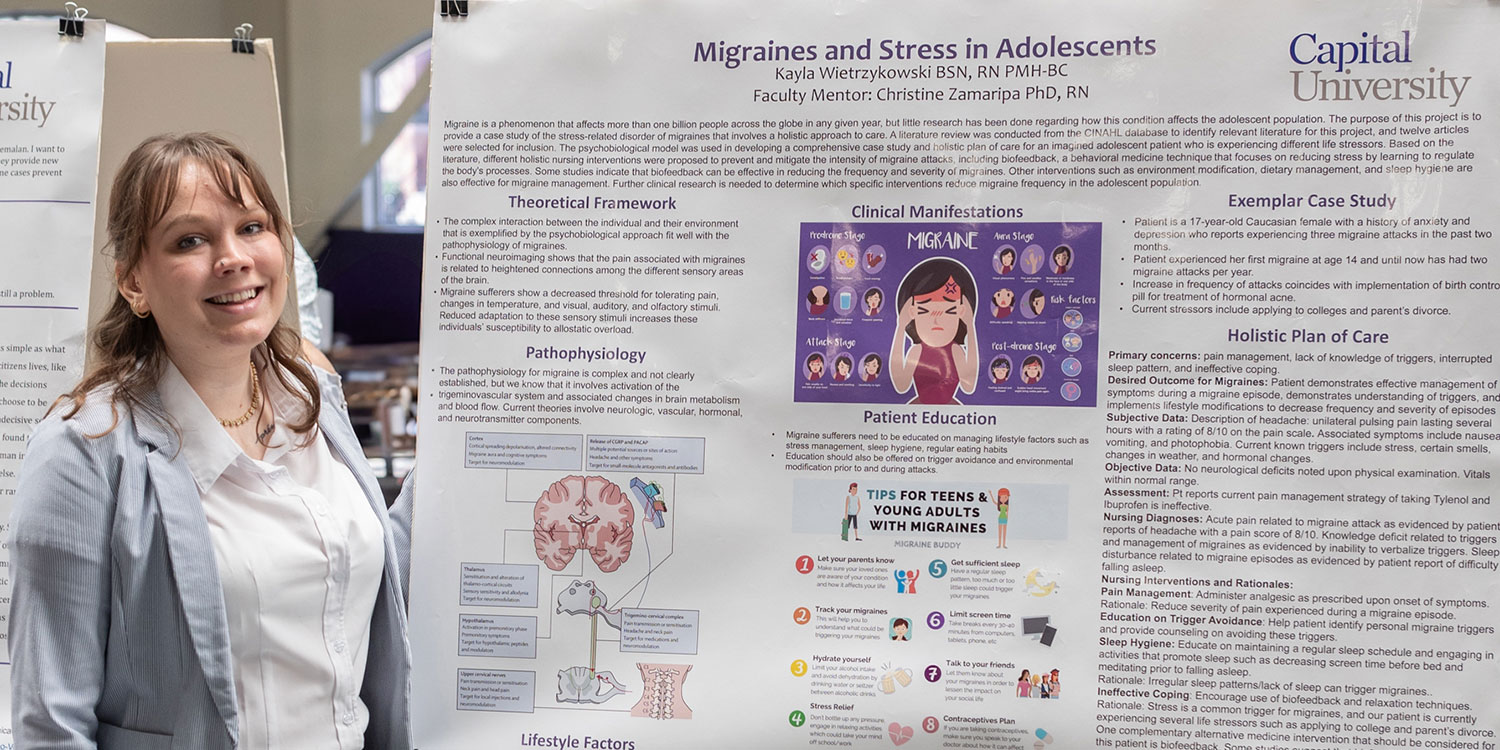Kayla Wietrzykowski, MSN ’27, nursing education, is no stranger to migraines. As a longtime sufferer, her personal connection to the condition inspired her to explore the stress-related disorder from a different angle, its prevalence and triggers in adolescents.
“Usually, these migraines start occurring during those adolescent years,” said Wietrzykowski. “I thought that with all of the stressors that teenagers have in their lives, especially right now, that can be contributing to the occurrence of migraines. It’s really important to take a look at that demographic.”
Wietrzykowski designed and presented her research project, “Migraines and Stress in Adolescents,” at the 29th Annual Undergraduate Research Symposium and 9th Annual Graduate Research Forum at Capital University on April 16, 2025.
Through her research, she quickly discovered how significant this connection could be.
“Teenagers are not getting enough sleep. They’re staying up late to work on homework. They’re stressed about college, and they have things going on at home too,” she said. “If we can target some of these stressors and mitigate them, we can mitigate migraines as well.”
One of the most surprising findings from her research was the effectiveness of holistic interventions, particularly biofeedback.
“These holistic interventions, including biofeedback, can be just as effective as medication,” she said. “Biofeedback looks at the body as a system and how stress is related to that.”
Techniques such as electromyography (EMG) and thermal biofeedback, used to track muscle tension and skin temperature, respectively, highlight the strong link between the vascular system and migraines.
Despite the growing attention on adolescent mental health, Wietrzykowski observed that most existing migraine literature still focuses on adults.
“There’s still a lot we don’t know about migraines,” she said. “The current theories involve neurologic, vascular, and hormonal components. It’s easy to get lost in the technical terms. What I wanted to focus on was looking at the patient on a more holistic level.”
Wietrzykowski’s interest in pediatric and psychiatric mental health is no coincidence. She currently works in the Child and Adolescent Partial Hospitalization Program at Nationwide Children’s Hospital, a role that has only deepened her passion for working with youth.
“I feel like I found a home here, and I’m certainly interested in exploring my opportunities within the organization in terms of serving a role as an educator,” she said. “My heart has always been in academia. That’s always been my aspiration, and it’s certainly the case with pursuing this master’s degree. I would love to teach in a university setting and spread my passion for psychiatric mental health and pediatrics with the future generation of nurses.”
Christine Zamaripa, PhD, RN, associate dean of Capital’s Graduate Program, praised Wietrzykowski’s initiative.
“Working alongside Kayla has been both engaging and meaningful. This collaboration reflects Capital Nursing's value of combining academic mentorship with real-world relevance, and I look forward to continuing our work together,” said Zamaripa.
“Kayla had the opportunity to explore this topic within her course work. Researching the connection between migraines and stress in adolescents is crucial because both are increasingly common and can significantly impact a young person’s quality of life. Migraines, often triggered or worsened by stress, can lead to frequent school absences, reduced academic performance, and emotional distress. Understanding the relationship between these two factors can help in developing effective prevention strategies, early interventions, and tailored treatments.”
For Wietrzykowski, the project marks just the beginning of her research journey.
“This was really the first time I’ve done something like this independently,” she said. “I hope people walk away with a greater appreciation for the stressors in young people’s lives and how that contributes to stress-related disorders. Just increasing awareness would be my main goal.”
For more information on student research at Capital, visit https://www.capital.edu/academics/experiential-learning/undergraduate-research/research-symposium/.
To learn more about Nursing at Capital, visit https://www.capital.edu/academics/nursing/.
